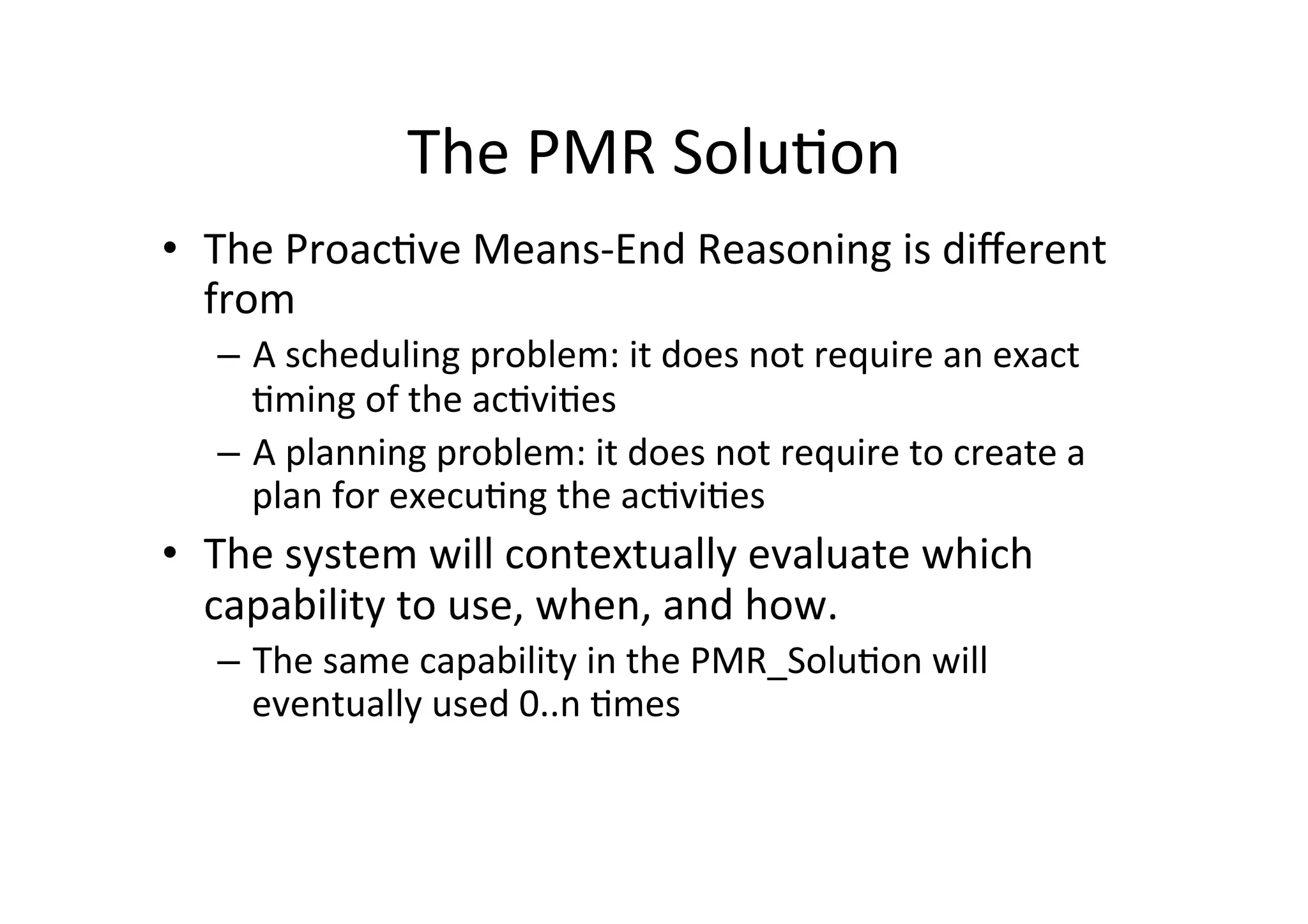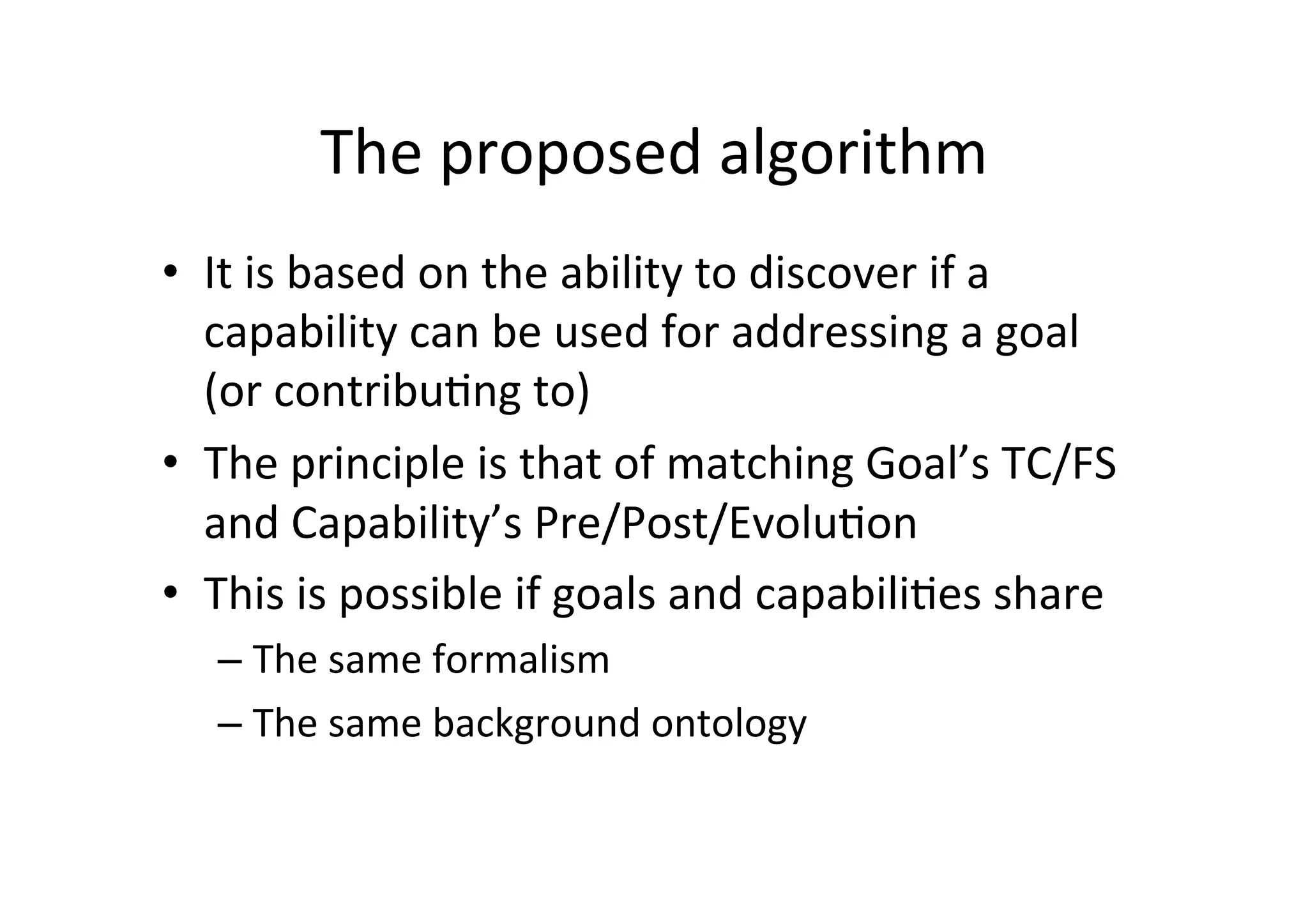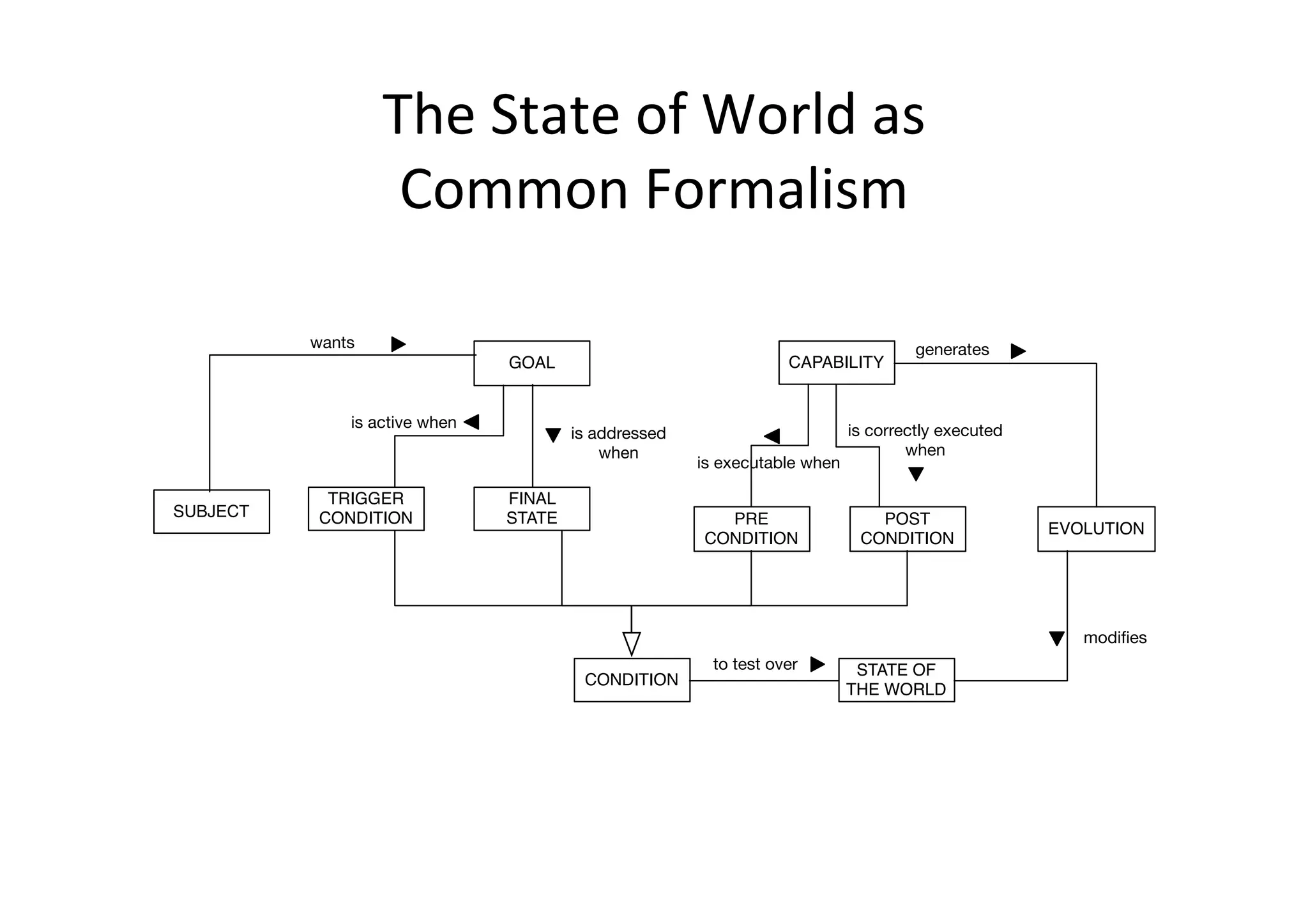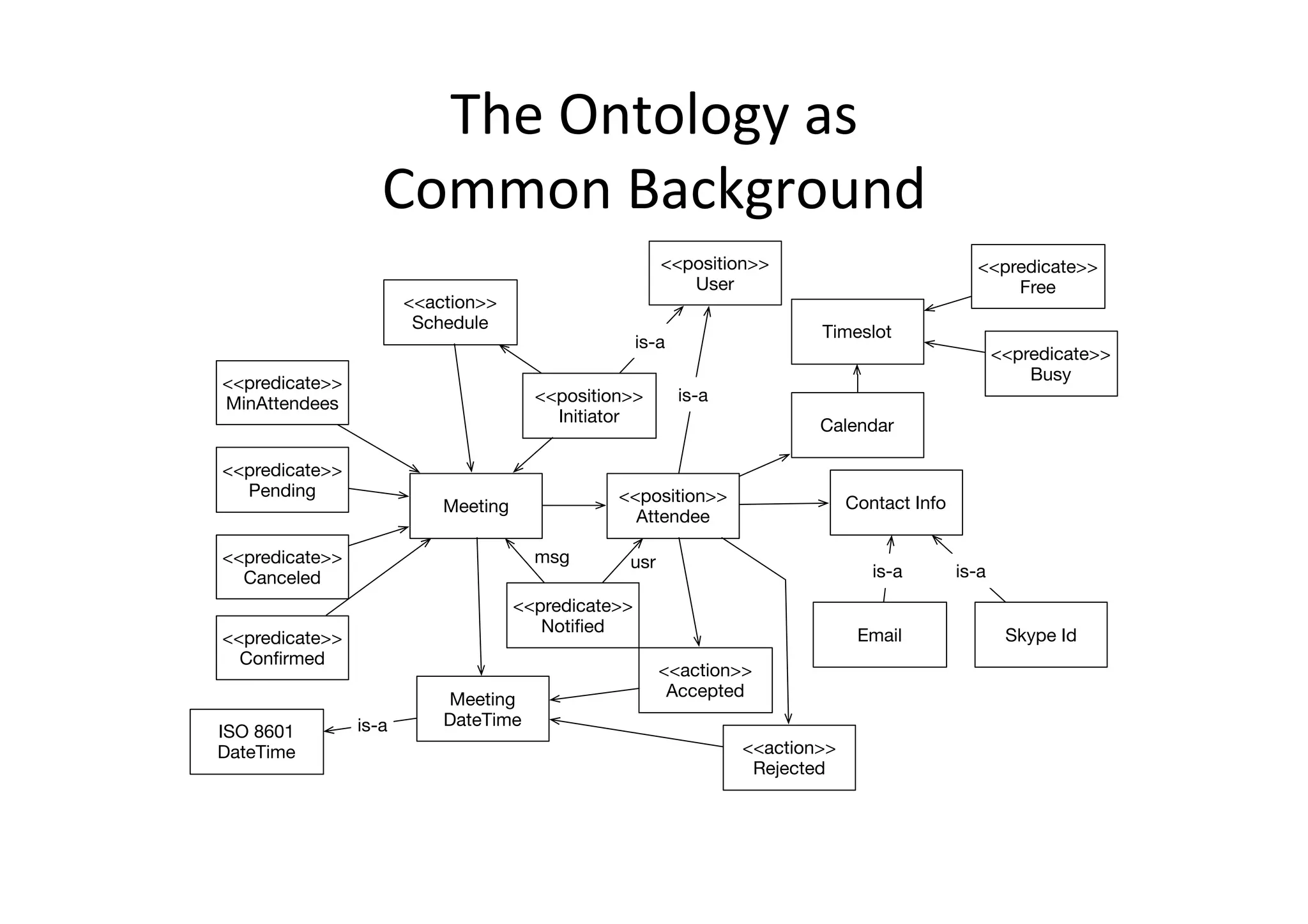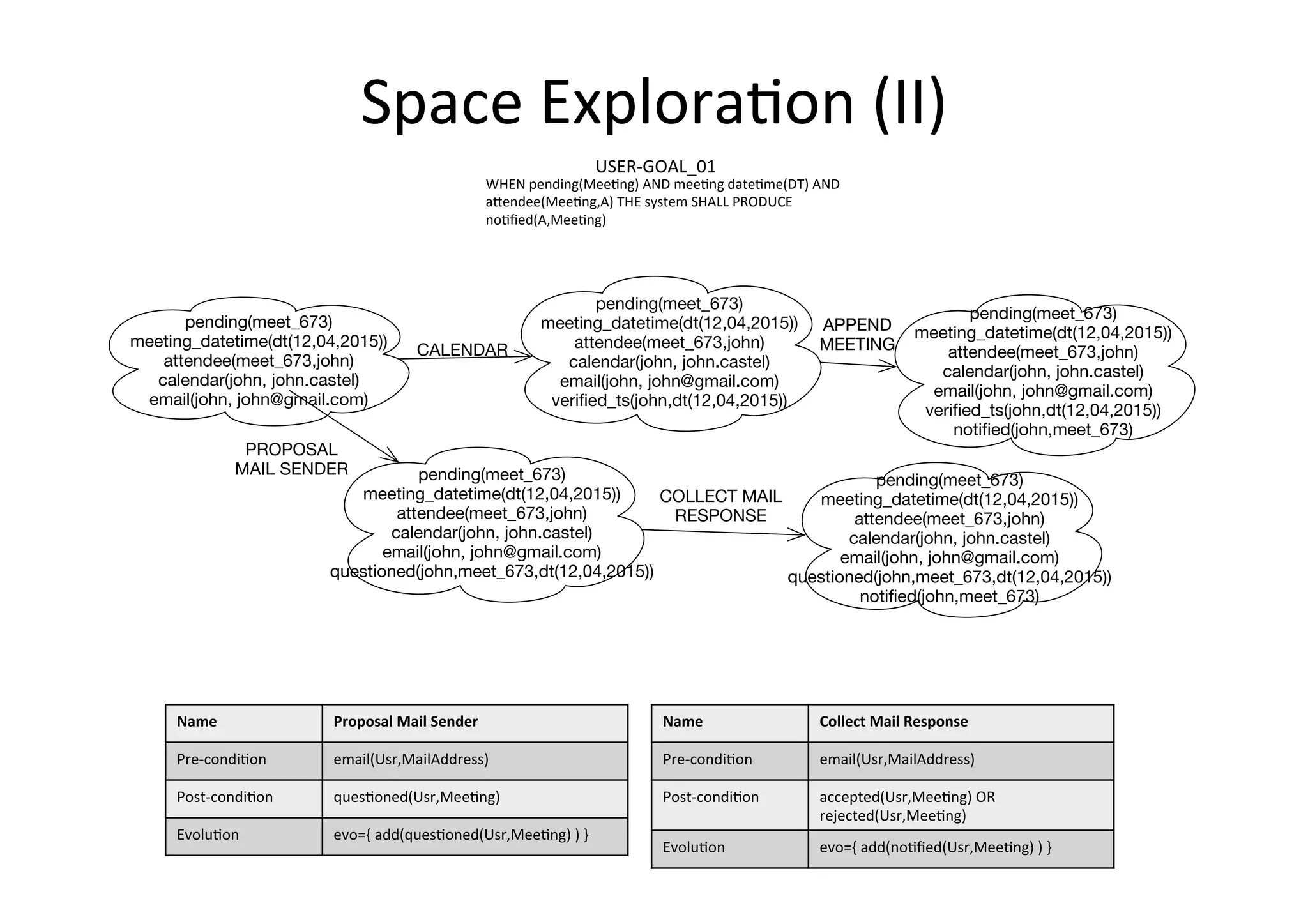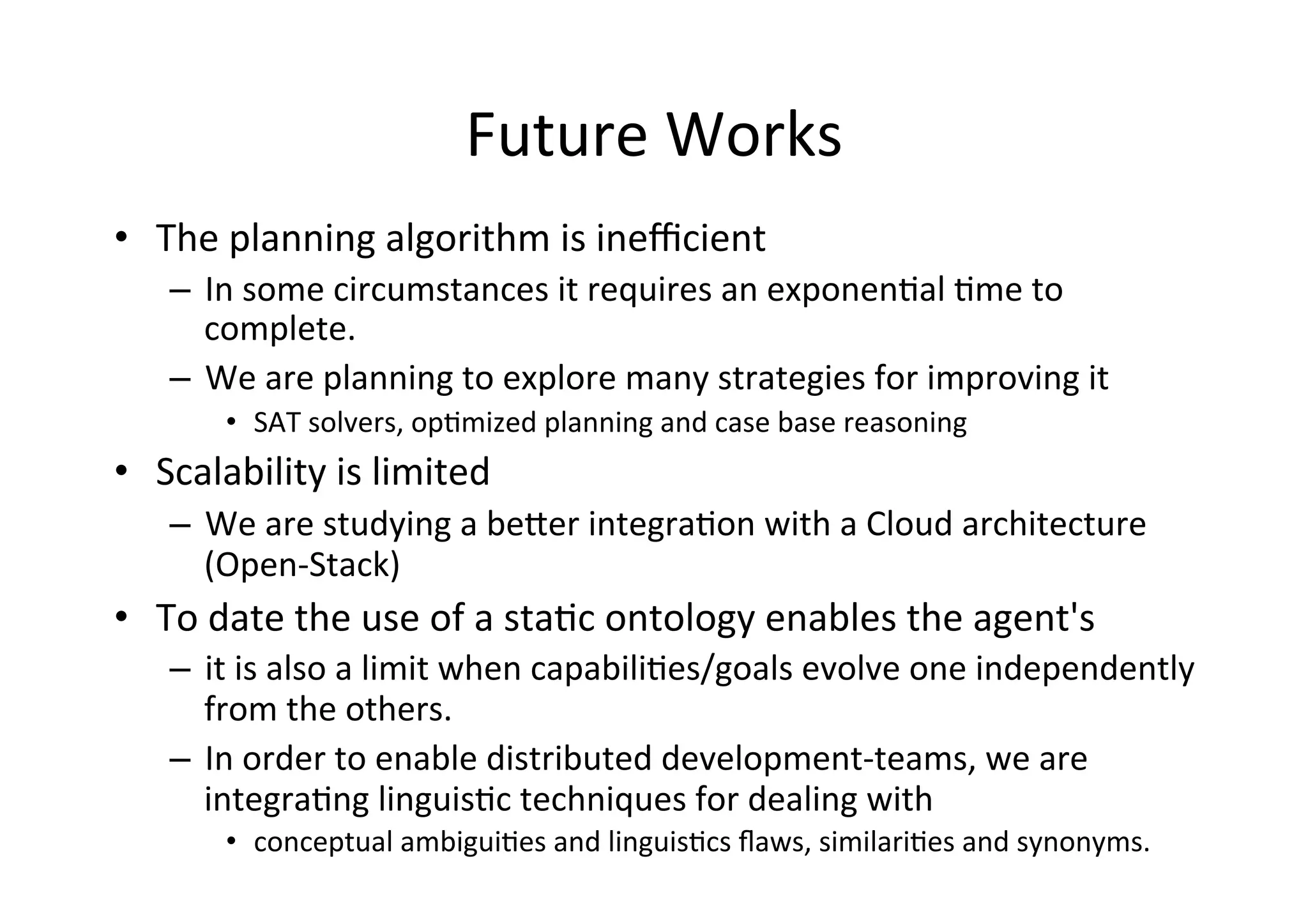The document discusses proactive means-end reasoning, emphasizing the identification of capabilities needed to achieve specific goals in system design. It outlines the structure of goal models and capabilities, their relationship, and how a system can automate scheduling tasks, such as meeting arrangements, based on defined trigger conditions and final states. Challenges such as scalability and planning inefficiencies are noted, with suggestions for future improvements through integrating advanced techniques and technologies.
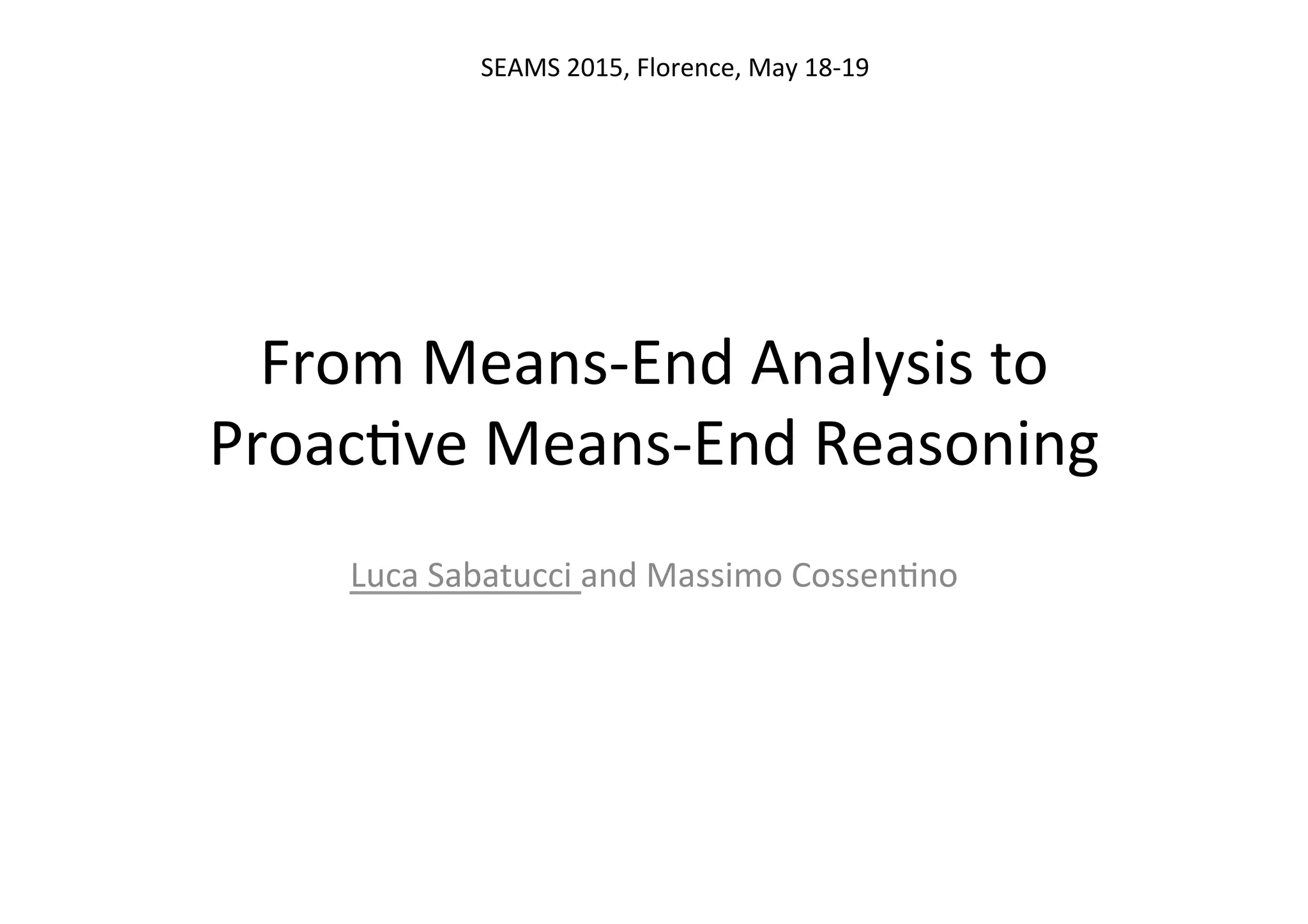
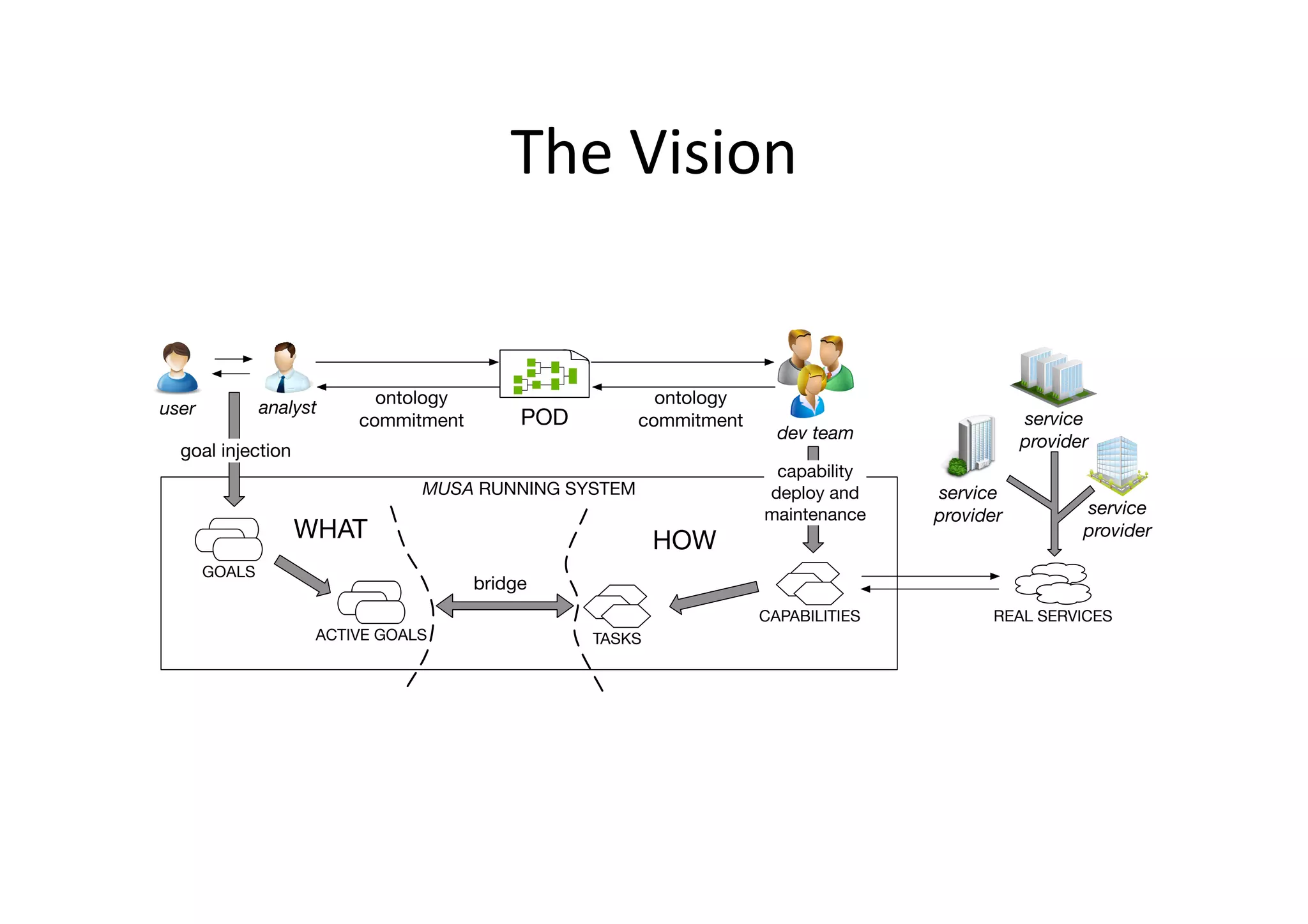
![Goal
Oriented
Requirements
• A
goal
is
a
state
of
affair
that
an
actor
wants
to
achieve
1 2 n
(1)
t believes all facts
) sj 62 Wt
t
) si 62 Wt (2)
nt subset of facts
everything that is
alse. An example
r instance the set
ate of world since
ion.
ration at time t.
a logic formula
h the standard set
on may be tested
unification.
ineering methods
state of affair that
Definition 3 (Goal Model). A goal model is a directed
graph, (G,R) where G is a set of goals (nodes) and R is
the set of Refinement and Influence relationships (edges). In
a goal model there is exactly one root goal, and there are no
refinement cycles.
Figure 2 is the partial goal model, represented with the i*
notation, for the meeting scheduling case study. This example,
redesigned from [15], includes functional (hard) goals only,
and AND/OR refinements. The root goal is to provide meeting
scheduling services that is decomposed in schedule meet-
ings, send reminders, cancel meetings and running a website.
Therefore meetings are scheduled by collecting participant
timetables, choosing a schedule and choosing a location. Such
a model is useful for analysts to explore alternative ways for
fulfilling the root goal.
OR
To Call
Participants
To Check
Calendars
To Mail
Participants
AND
To Provide
Meeting
Scheduling
To
Schedule
Meetings
To Sent
Reminders
To Cancel
Meetings
To Run
Website
AND
To Collect
Timetables
To
Choose
Schedule
To
Choose
Location
[…] […]
[…] […]
[…]
Fig. 2. Portion of Goal Model taken from [15] for the Meeting Scheduling
case study. For reasons of space, the tree has been truncated (with respect to
the original one) where the symbol [...] appears.
C. Capability Definition
In many goal-oriented approaches, a Task is the operational-
ization of a Goal. This means that each task, in a goal model,
GOAL
MODEL
To Mail
Participants
Mail
Questio
nnaire
Sender
MEANS-‐END
ANALYSIS](https://image.slidesharecdn.com/slidesseams15-150620130940-lva1-app6891/75/SlidesSeams15-3-2048.jpg)
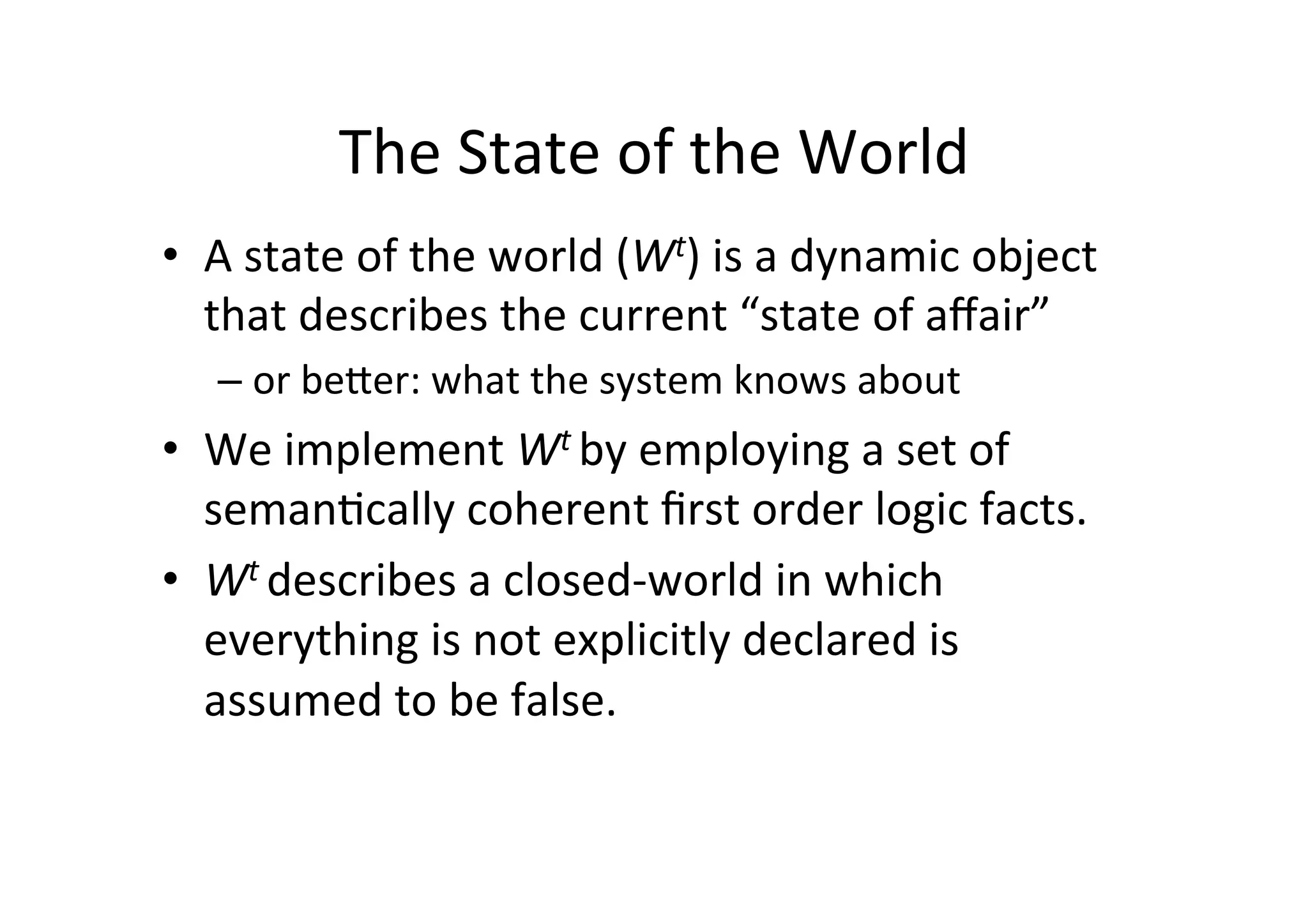
![Opera5ve
Implementa5on
of
Goal
• Goal's
TC
is
the
Condi5on
that
must
hold
in
Wt
in
order
the
agent
can
ac5vely
pursue
that
goal.
• Goal's
FS
is
the
Condi5on
that
must
hold
in
Wt
in
order
the
goal
can
be
marked
as
addressed.
• GOALSpec
is
a
language
conceived
to
inject
goal
specifica5ons
in
a
human-‐friendly
format
GOAL LIFECYCLE
Injected ActiveReadycommit
FS=true
FS=false
TC=true
state failurecommitment failure
[maintain-goal]
[achieve-goal]
Addressed
goal retreat
goal injection
GOAL
SUBJECT
TRIGGER
CONDITION
FINAL
STATE
EVENT STATE OF
THE WORLD
wants
is active when
is addressed
when
generated by composed of
Fig. 7. The Core Metamodel of the Goal Specification Language.
a Trigger Condition and a Final State. The subject is a noun
that describes the name of the involved person, role or group
of persons that owns the responsibility to address the goal. The
trigger condition is an event that must occur in order to start
acting for addressing the goal. The final state is the desired
state of the world that must be addressed.
It is worth underlining that both Trigger Conditions and
Final States must be expressed by using a State of the World,
that in turn is expressed through domain ontology predicates.
For a complete specification of the syntax of GoalSPEC
see [32]. Some examples of GoalSPEC productions for the
domain of the Meeting Scheduling are listed below:
1) WHEN schedule(Usr,Meeting) THE system SHALL
PRODUCE canceled(Meeting) OR confirmed(Meeting)
2) WHEN pending(Meeting) AND meeting datetime(DT) AND
attendee(Meeting,A) THE system SHALL PRODUCE
is able to achieve a goal by doing an action if i) the agen
knows what the action is and ii) knows that doing the action
would result in the goal being satisfied [21]. This topic ha
become even more current because the amount of service
deployed in the web is exponentially growing and researcher
are looking for ways for automatically searching, selecting and
composing them [35].
We use Capability as an internal representation of an atomi
unit of work that a software agent may use for addressing
changes in the state of the world. A Capability is made o
two components: an abstract description (a set of beliefs tha
makes an agent aware of owning the capability and able to
reason on its use), and a concrete body implementation (a se
of plans for executing the job).
Whereas we define a template for providing the abstrac
description of a capability, we do not provide any language fo
the body, leaving the choice of the specific technology to th
developer. The proposed template (Table I) is a refinement o
that presented in [35] for LARKS (language for advertisemen
and request for knowledge sharing).
TABLE I
TEMPLATE FOR DOCUMENTING A CAPABILITY DESCRIPTION.
Name Unique label used to refer to the capability
InputParams Definition of the input variables necessary for
the execution.
OutputParams Definition of the output variables produced by
the execution.
Constraints Optional (logical or structural) constraints on
input/output variables.
Pre-Condition Condition that must hold in the current state of
GOAL
SUBJECT
TRIGGER
CONDITION
FINAL
STATE
EVENT STATE OF
THE WORLD
wants
is active when
is addressed
when
generated by composed of
Fig. 7. The Core Metamodel of the Goal Specification Language.
a Trigger Condition and a Final State. The subject is a noun
that describes the name of the involved person, role or group
of persons that owns the responsibility to address the goal. The
trigger condition is an event that must occur in order to start
acting for addressing the goal. The final state is the desired
state of the world that must be addressed.
It is worth underlining that both Trigger Conditions and
Final States must be expressed by using a State of the World,
that in turn is expressed through domain ontology predicates.
For a complete specification of the syntax of GoalSPEC
see [32]. Some examples of GoalSPEC productions for the
domain of the Meeting Scheduling are listed below:
1) WHEN schedule(Usr,Meeting) THE system SHALL
PRODUCE canceled(Meeting) OR confirmed(Meeting)
2) WHEN pending(Meeting) AND meeting datetime(DT) AND
attendee(Meeting,A) THE system SHALL PRODUCE
notified(A,Meeting,DT)
3) AFTER 2 days SINCE WHEN notified(Usr,Meeting,DT)
is able to
knows wha
would resu
become ev
deployed i
are looking
composing
We use C
unit of wo
changes in
two compo
makes an
reason on
of plans fo
Whereas
description
the body, l
developer.
that presen
and reques
TEMPL
Name
InputPara
OutputPa
Constrain
Pre-Cond
Post-Con
USER-‐GOAL_01
USER-‐GOAL_02](https://image.slidesharecdn.com/slidesseams15-150620130940-lva1-app6891/75/SlidesSeams15-5-2048.jpg)
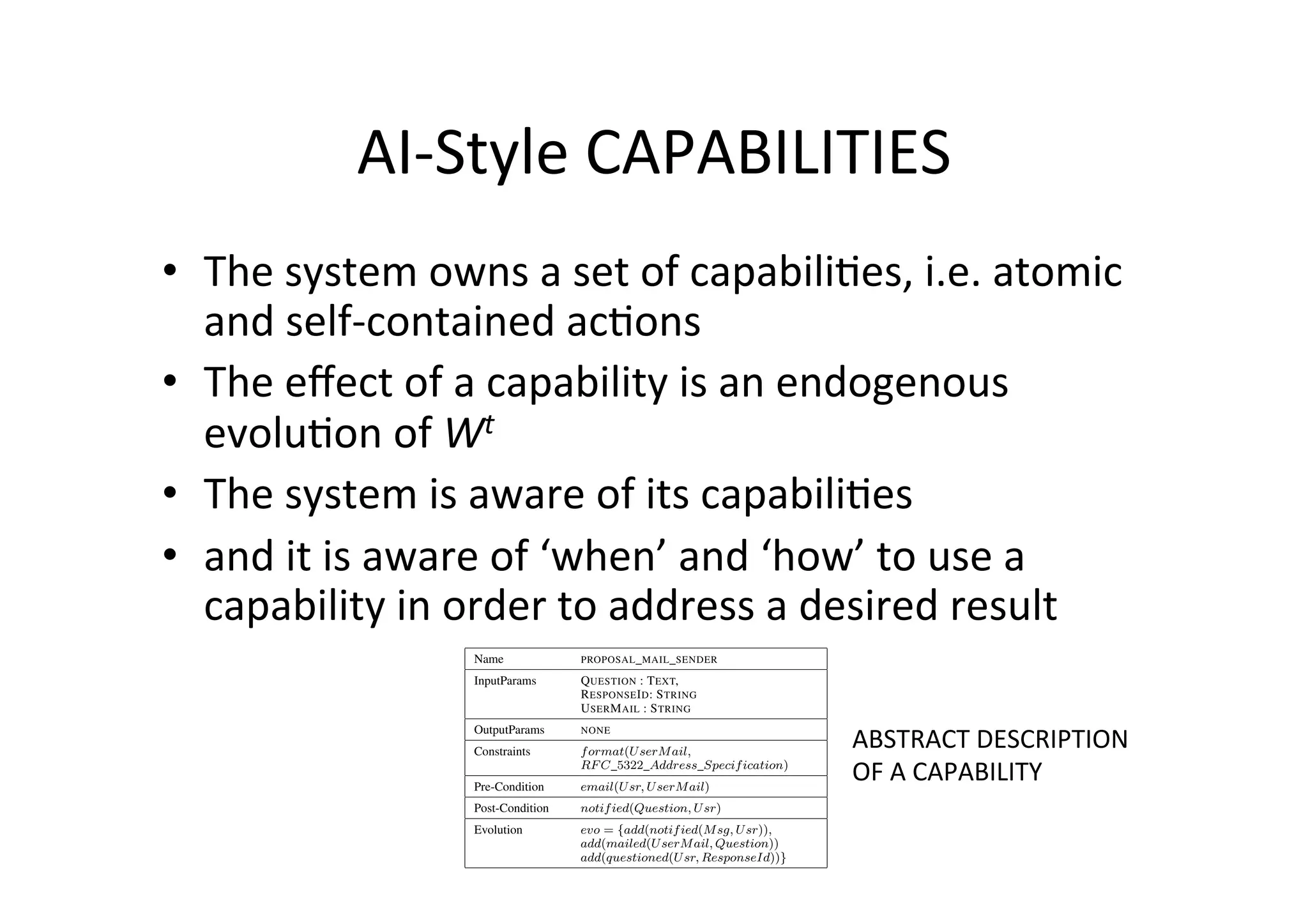
![Bridging
WHAT
and
HOW
user analyst dev team
CALENDAR
goal injection capability
deploy and
maintenance
bridge
WHAT (goal spec)
HOW (capabilities)WHEN pending(Meeting)
AND meeting datetime(DT)
AND attendee(Meeting,A)
THE system SHALL
PRODUCE
notified(A,Meeting,DT)
PROPOSAL MAIL SENDER
COLLECT_MAIL_RESPONSES
GOOGLE_CALENDAR_CHECK
MAILER
OR
To Call
Participants
To Check
Calendars
To Mail
Participants
AND
To Provide
Meeting
Scheduling
To
Schedule
Meetings
To Sent
Reminders
To Cancel
Meetings
To Run
Website
AND
To Collect
Timetables
To
Choose
Schedule
To
Choose
Location
[…] […]
[…] […]
[…]
MUSA RUNNING
SYSTEM
google
The
PROACTIVE
MEANS-‐END
REASONING
is
the
problem
of
finding
the
minimal
set
of
capabili5es
(called
PMR
Solu5on)
that
can
fully
address
a
goal
model,
given
the
current
Wt.](https://image.slidesharecdn.com/slidesseams15-150620130940-lva1-app6891/75/SlidesSeams15-7-2048.jpg)
